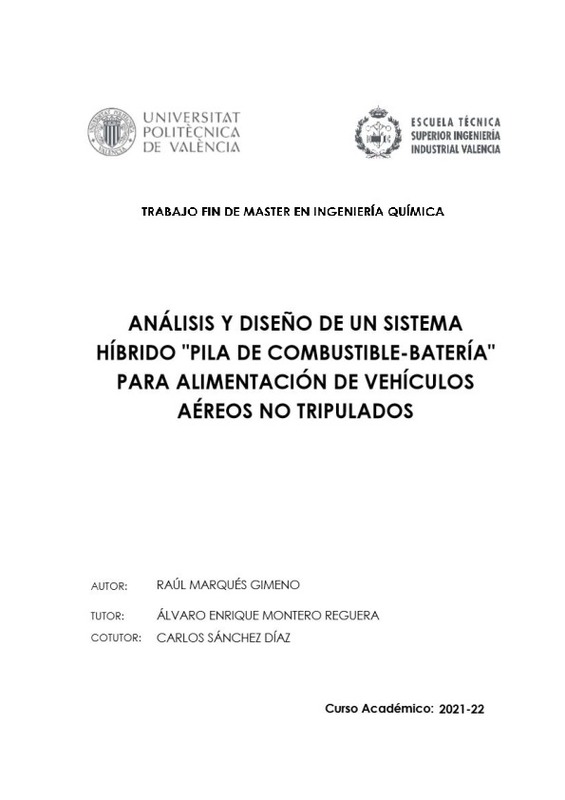|
Resumen:
|
[ES] En la actualidad, existe una mayor conciencia social sobre los problemas medioambientales relacionados con el consumo excesivo de combustibles fósiles, tanto en el sector del transporte como en la generación de energía ...[+]
[ES] En la actualidad, existe una mayor conciencia social sobre los problemas medioambientales relacionados con el consumo excesivo de combustibles fósiles, tanto en el sector del transporte como en la generación de energía eléctrica mediante las centrales térmicas convencionales. Además, debido al incremento en las necesidades energéticas globales, se requiere una transición progresiva hacia modelos energéticos que resulten mucho más sostenibles y respetuosos con el medioambiente.
En este sentido, la tecnología del hidrógeno y su aplicación en las celdas de combustible representan una alternativa que permite reducir las emisiones contaminantes y los gases de efecto invernadero que contribuyen al fenómeno del calentamiento global, garantizando una mayor independencia y autosuficiencia energética.
El presente Trabajo Final de Máster tiene como objetivo realizar el diseño, modelado y simulación de un sistema híbrido ¿pila de combustible-batería¿ como fuente de alimentación para un vehículo aéreo no tripulado. La estrategia de control es garantizar el funcionamiento del vehículo durante la fase de vuelo estacionaria mediante una pila de combustible del tipo PEMFC y utilizar una batería LiPo auxiliar para alcanzar los picos de demanda en las fases de despegue y aterrizaje.
Mediante simulación, se analiza la respuesta dinámica del sistema modelado frente a una curva de demanda semiempírica y se comprueba el potencial del conjunto híbrido como solución para mejorar la autonomía de un dron sanitario o de emergencia, lo que permitiría al vehículo recorrer mayores distancias y realizar intervenciones de rescate en zonas de difícil acceso.
Los resultados obtenidos con el modelo de simulación pretenden contribuir a la implementación de esta tecnología híbrida en vehículos aéreos no tripulados, sirviendo también como referencia para posibles investigaciones futuras sobre el desarrollo de nuevos sistemas híbridos eléctricos dentro del sector automovilístico.
[-]
[EN] Currently, there is an increasing social awareness of the environmental problems related to the excessive consumption of fossil fuels, both in the transport sector and in the generation of electricity through conventional ...[+]
[EN] Currently, there is an increasing social awareness of the environmental problems related to the excessive consumption of fossil fuels, both in the transport sector and in the generation of electricity through conventional thermal power plants. In addition, due to the increase in global energy requirements, a progressive transition towards more sustainable and environmentally friendly energy models is required.
In this context, the hydrogen technology and its application on fuel cells is considered as an alternative option for reducing the polluting emissions and greenhouses gases involved in the phenomenon of global warming, providing a greater energy independence and self-sufficiency.
The aim of this Master Final Work is the design, modelling and simulation of a hybrid ¿fuel cell-battery¿ system as a power supply unit for Unmanned Aerial Vehicles (UAV or drones). The control strategy is to ensure the vehicle operation during the hover flight phase by means of a PEMFC fuel cell stack, requiring an auxiliary LiPo battery to meet peak demand during the take-offs and landing phases.
Through simulation software, the dynamic response of the modelled hybrid system to a semi-empirical demand curve is analyzed and the potential of the hybrid assembly is tested as a solution to improve the autonomy of a medical or emergency drone, which would allow the vehicle to travel longer distances and perform rescue interventions in difficult access areas.
The conclusions obtained from the simulation model are intended to contribute to the implementation of this hybrid technology in Unmanned Aerial Vehicles, also serving as a reference for possible future research on the development of new hybrid electric systems within the automotive sector.
[-]
|







